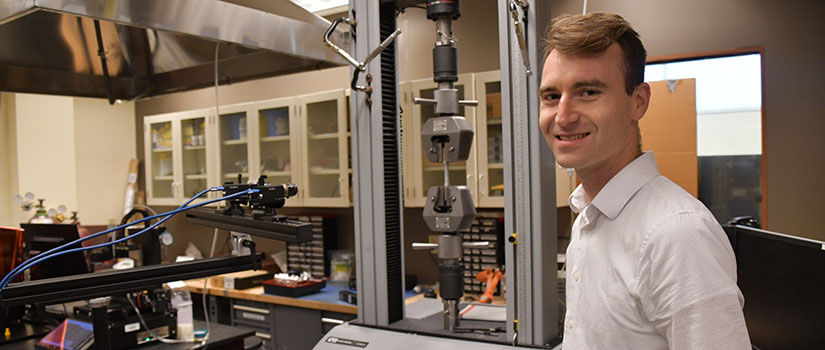Andrew Gross’s project aims to develop the next generation of material testing methods.
Material properties are precise engineering measurements that answer questions like, “How strong is this material?” or “How much can this material stretch before it breaks?”
Engineers rely on material properties to make their designs. While the arduous process of materials testing has seen slow and steady improvements over the last 100 years, the amount of material property information that engineers obtain from each test has not increased. Meanwhile, the need for more material property information has been driven by the advent of advanced materials that have complex behavior and new manufacturing processes like 3D printing.
Mechanical Engineering Assistant Professor Andrew Gross recently received a Defense Advanced Research Projects Agency (DARPA) Young Faculty Award to pursue research that addresses this issue. The award identifies and engages rising stars in junior research positions to develop innovative new research directions related to Department of Defense needs. Gross’s project will be a two-year, $500,000 funded award, with an option for a third year.
Gross’s lab is developing a fundamentally new approach that uses the power of digital cameras and computer simulations to reduce the time and cost required to measure material properties. The work aims to rapidly accelerate the pace at which advanced materials and new manufacturing processes can be used for engineered products.
The goal of my research is to essentially answer the question, ‘How can we take things that are observable in the lab and convert it to a material property?'
- Andrew Gross
Gross’s new approach relies on mainstays of modern engineering, including digital image correlation (DIC), which was invented at the University of South Carolina by Mechanical Engineering Distinguished Professor Michael Sutton in 1982.
“DIC lets us measure how much deformation has occurred over the surface of our test piece. We have this power to see more in the lab now, but it’s not being used to change how we do material characterization,” Gross says.
Gross’s method for discovering material properties will be data-rich experiments, which rely on finite element analysis to distill large amounts of data into standard material properties.
“We’ll take these data dense measurements from the lab that are hard to decipher and compare them to computations on a replica of the experimental specimen. Then we’ll keep on refining that replica until it matches the laboratory test. Once the two match, we’ll know that we’ve found the material properties,” Gross says.
Gross added that typical experiments provide data on a single test condition for a material. However, he will look at doing one experiment to get data on hundreds of tests conditions. “What would have happened over the course of many experiments in the past will now be packed into one experiment,” Gross says.
According to Gross, he believes his research could be utilized in the sheet metal forming manufacturing process, which cuts and forms thin metal sheets into desired shapes that are used in a wide array of products, such as home appliances, cars and airplanes.
“Sheet metal forming is an important industry as we move toward advanced materials, such as titanium or magnesium. These advanced materials can make vehicles more lightweight and decrease carbon dioxide emissions, but their use is limited because they are more difficult to form than steel.”
Gross added that a major reason why industries do not use more advanced materials is due to the exhaustive qualification and acceptance protocols necessary for certifying materials so they can be used safely. His research intends to decrease the burden of meeting material certifications by obtaining more information from each of his experiments.
“Decreasing the experimental burden could especially be helpful for additive manufacturing (3D printing), where new materials can be made with several different methods,” Gross says. “With some additive manufacturing techniques, you can change the composition and create different alloys in one build. But it’s a qualification and certification nightmare because you have to certify a spectrum of materials instead of just one material.”
“The goal of my research is to essentially answer the question, ‘How can we take things that are observable in the lab and convert it to a material property?’ I'm really interested because I think that’s a question nobody's asking right now,” Gross says.
